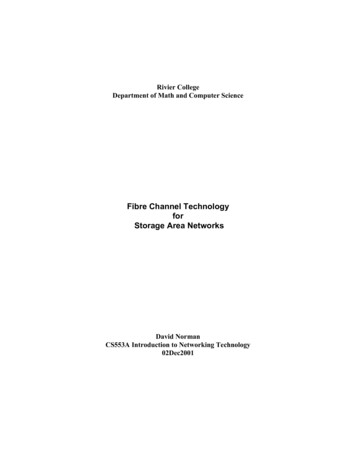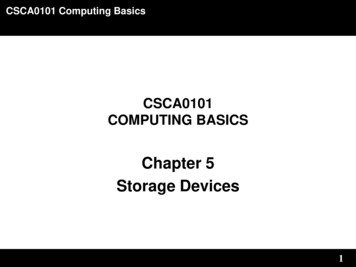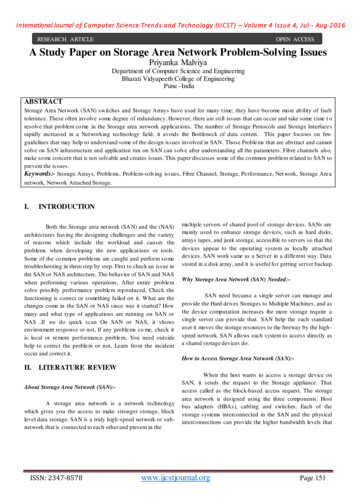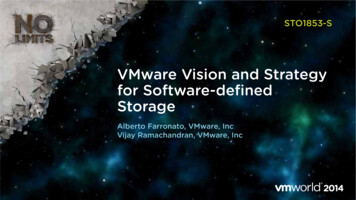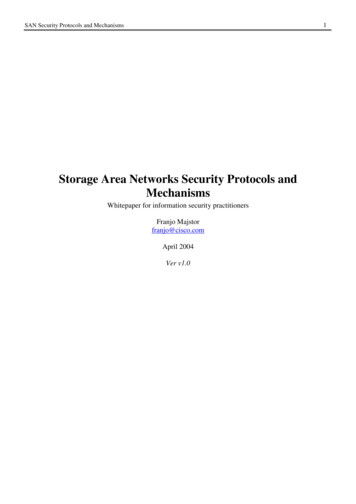
Transcription
1SAN Security Protocols and MechanismsStorage Area Networks Security Protocols andMechanismsWhitepaper for information security practitionersFranjo Majstorfranjo@cisco.comApril 2004Ver v1.0
2SAN Security Protocols and MechanismsStorage Area Networks Security Protocols andMechanismsIndex of Content1Introduction and scope.42SAN technology and protocols overview .42.12.22.32.42.52.63SAN Security Threats Analysis .103.13.23.34DAS vs. NAS vs. SAN .4Small Computer Systems Interface known as SCSI.6Internet SCSI .6Fibre Channel.7Fibre Channel over TCP/IP .8Other SAN Protocols .9Availability .10Confidentiality and Integrity.10Access Control and Authentication .11SAN Security Mechanisms.114.1Securing FC fabric.114.1.1Zoning.114.1.2LUN Masking .124.1.3Fibre Channel Security Protocols .134.1.3.1 FC-SP Authentication and Key Management Protocols .134.1.3.1.1 Diffie-Hellman Challenge Handshake Authentication Protocol .134.1.3.1.2 Fibre Channel Authentication Protocol .144.1.3.1.3 Fibre Channel Password Authentication Protocol.144.1.3.1.4 FC-SP Authentication protocols comparison .144.1.3.2 FC-SP per frame confidentiality and integrity.154.2Securing Storage over IP Protocols .164.2.1IP Security Protocol overview .164.2.2iSCSI Security Mechanisms .184.2.3iFCP, FCIP and iSNS Security Mechanisms.195Storage Security Standard Organisations and Forums .196Future directions.207Summary .208References.21
3SAN Security Protocols and MechanismsIndex of ExhibitsExhibit 2: NAS Architecture .5Exhibit 3: SAN Architecture .5Exhibit 4: iSCSI Encapsulation. .6Exhibit 5: iSCSI Solution Architecture .7Exhibit 6: Fibre Channel Protocol Stack .8Exhibit 7: FCIP Encapsulation. .8Exhibit 8: FCIP and iSCSI Solution Architecture .9Exhibit 9: FC Zoning Example.11Exhibit 10: FC-SP Authentication and Key Management Protocols.14Exhibit 11: Fibre Channel Security Protocol Frame.16Exhibit 12: IPsec Transport and Tunnel Mode.18Exhibit 13: FC SP Policy Distribution and Key Management options .20
4SAN Security Protocols and MechanismsStorage Area Networks Security Protocols and Mechanisms1Introduction and scopeStorage devices were up to fairly recently locked into a glass room and hence was the data stored on themenjoying privileges of the physical data center security and protection mechanisms. With a developmentof a Storage Area Network (SAN) technology, hard drives and tape drives are not necessarily directlyattached to a host any more but could be rather physically distant up to several hundred kilometers oreven around a globe. Such a flexibility of logically instead of physically attached storage devices to a hostmade them remotely accessible and highly available, however it brought into a consideration all securityelements of the modern network environment like privacy, integrity of the data in transit andauthentication of the remotely connected devices. From the data perspective, we could distinguish thestorage network security, which refers to protection of the data while it is in transit versus storage datasecurity to which we refer when the data is stored on the tapes or the hard drives. Focus of this article isto make the information security professionals aware of the new communication protocols andmechanisms for storage network security, explain threats and their security exposures as well as describeguidelines for their solutions.22.1SAN technology and protocols overviewDAS vs. NAS vs. SANHistorically, storage devices, such as disk drives and backup tapes, were directly attached to a host, hencethe name Direct Attached Storage or DAS. This was typically performed via SCSI (Small ComputerSystems Interface) parallel bus interface with a speed of up to 320 MBps. This approach of attachingstorage devices is coming from internal computer architecture which has obviously got to its limits inseveral ways. Number of devices which could be attached to one bus is limited even in latest version ofSCSI protocol to only 16 devices while the distances are not bigger than 15 meters. Sharing disk or tapesdrives amongst multiple hosts were due to architecture of DAS impossible or required specialized andtypically expensive software or controllers for device sharing. On the other side, utilisation of the storagespread across the multiple servers was typically lower than on one single pool. Often necessaryexpansions of storage volumes and replacement of the failed hard drives have in DAS architecturefrequently generated system downtimes. DAS Architecture is illustrated in Exhibit 1.Exhibit 1: DAS Architecture.The effort to get a better usage of storage devices by the multiple hosts has generated specialized devicesfor shared storage access on the file level. This architecture is commonly referred as Network Attached
5SAN Security Protocols and MechanismsStorage or shortly NAS. NAS architecture consist of a dedicated device named Filer which is actually astripped down and optimized host for very fast network file sharing. Two most typically supported filesystems on Filers are NFS (Network File Systems) for a Unix world and CIFS (Common Internet FileSystem) for the Microsoft world. . While NAS solution has its main advantage in simplicity inmaintenance and installation, its main drawback is limited file and operating system support or support offuture new file systems. Architecture of a NAS is illustrated in Exhibit 2.Exhibit 2: NAS ArchitectureThe latest mechanism of attaching storage remotely with a block level access is commonly referred asStorage Area Network or SAN. SAN consist of hosts, switches and storage devices. Hosts equiped withHost Bus Adapters (HBA) are attached via optical cable to a storage switches which act as a fabricbetween the hosts and the storage devices. SAN architecture is illustrated in Exhibit 3.Exhibit 3: SAN Architecture
6SAN Security Protocols and MechanismsThe invention of a Fibre Channel (FC) has opened a complete new era in the way the storage devices gotconnected to each other and to hosts. First advantage was the greater distance with up to 10 km, while thedifferent topologies also opened a much bigger number of storage devices that could get connected andshared amongst the multiple hosts.2.2Small Computer Systems Interface known as SCSIIn the long history of adaptations and improvements, the line sometimes blurs between where one SmallComputer System Interface (SCSI) ends and another begins. The original SCSI standard approved in1986 by the American National Standards Institute (ANSI), supported transfer rates of up to 5 MBps(megabytes per second) which is, measured by today's standards, slow. Worse yet, it supported a veryshort bus length. When original SCSI was introduced, however, it represented a significant improvementover what was available at that time, but the problem was the compatibility - since many vendors offeredtheir own unique SCSI options. The next generation of SCSI standard SCSI-2, incorporated SCSI-1 as itssubset. In development since 1986, SCSI-2 gained its final approval in 1994 and resolved many of thecompatibility issues original SCSI-1 faced. With SCSI-2, it was possible to construct more complexconfigurations using a mix of peripherals. The most noticeable benefit of SCSI-2 over SCSI-1 was itsspeed. Also called Fast SCSI, SCSI-2 typically supported bus speeds up to 10 MBps but could go up to20 MBps when combined with fast and wide SCSI connectors. Fast SCSI enabled faster timing on the bus(from 5 to 10 MHz), thereby providing for higher speed. Wide SCSI used an extra cable to send datathat's 16 or 32 bits wide, which allowed for double or quadruple the speed over the bus versus standard,narrow SCSI interfaces that were only 8 bits wide. The latest specification of SCSI protocol, SCSI-3 wasamong other improvements the first one that did a separation of the higher level SCSI protocol from thephysical layer. This was the prerequisite of giving alternatives to run SCSI commands on top of differentphysical layers than the parallel bus. Hence the SCSI-3 specification was the basis of porting the SCSIprotocol to different media carriers such as Fibre Channel or even other transport protocols as TCP/IP.2.3Internet SCSIThe SCSI-3 protocol has been mapped over various transports such as parallel SCSI, IEEE-1394(firewire) and Fibre Channel. All these transports have their specifics but also all have limited distancecapabilities. The Internet SCSI or shortly iSCSI protocol is the IETF draft standard protocol thatdescribes means of transporting SCSI packets over TCP/IP. The iSCSI interoperable solution can takeadvantage of existing IP network infrastructure which have virtually no distance limitations.Encapsulation of the SCSI frames in the TCP/IP protocol is illustrated in Exhibit 4.Exhibit 4: iSCSI Encapsulation.The primary market driver for the development of the iSCSI protocol was to enable broader access of thelarge installed base of DAS over IP network infrastructures. By allowing greater access to DAS devicesover IP networks, storage resources can be maximized by any number of users or utilized by a variety ofapplications such as remote backup, disaster recovery, and storage virtualization. A secondary driver ofiSCSI is to allow other SAN architectures such as Fibre Channel to be accessed from a wide variety ofhosts across IP networks. iSCSI enables block-level storage to be accessed from Fibre Channel SANsusing IP storage routers or switches, furthering its applicability as an IP-based storage transport protocol.iSCSI defines the rules and processes to transmit and receive block storage applications over TCP/IPnetworks. Although iSCSI can be supported over any physical media that supports TCP/IP as a transport,most iSCSI implementations runs on Gigabit Ethernet. iSCSI protocol can run in software over astandard Gigabit Ethernet network interface card (NIC) or can be optimized in hardware for betterperformance on an iSCSI host bus adapter (HBA).
SAN Security Protocols and Mechanisms7iSCSI enables SCSI-3 commands to be encapsulated in TCP/IP packets and delivered reliably over IPnetworks. As it sits above the physical and data-link layers, iSCSI interfaces to the operating system'sstandard SCSI access method command set to enable the access of block-level storage that resides onFibre Channel SANs over an IP network via iSCSI-to-Fibre Channel gateways such as storage routers andswitches. iSCSI protocol stack building blocks are illustrated in Exhibit 5.Exhibit 5: iSCSI Solution ArchitectureInitial iSCSI deployments were targeted at small to medium-sized businesses and departments or branchoffices of larger enterprises that have not deployed Fibre Channel SANs yet, however iSCSI is also anaffordable way to create IP SANs from a number of local or remote DAS devices. If there is FibreChannel present, as it is typically in a data center, it could be also accessed by the iSCSI SANs via aniSCSI-to-Fibre Channel storage routers and switches.2.4Fibre ChannelFibre Channel (FC) is an open industry standard serial interface for high-speed systems. FC is a protocolfor transferring the data over fibber cable that consists of multiple layers covering different functions. Asa protocol between the host and a storage device, FC was really out of a scope of an average informationtechnology professional for a simple reason that it was point to point connection between the host with aHBA and storage device of typically same vendor which did not require any knowledge or understandingexcept maybe during the installation process. From the speed perspective, FC is available already inflavors of 1 Gbps and 2 Gbps while specifications for 4Gbps as well as 10Gbps are being worked on andare not that far away.FC protocol stack is defined in a standard specification of a Technical Committee T11.3 of an INCITS(InterNational Committee for Information Technology Standards) and is illustrated in Exhibit 6.
8SAN Security Protocols and MechanismsExhibit 6: Fibre Channel Protocol StackThe lowest level (FC-0) defines the physical link in the system, including the fibre, connectors, opticaland electrical parameters for a variety of data rates. FC-1 defines the transmission protocol includingserial encoding and decoding rules, special characters and error control.The Signaling Protocol (FC-2) level serves as the transport mechanism of Fibre Channel. It defines theframing rules of the data to be transferred between ports, mechanisms for controlling the different serviceclasses and the means of managing the sequence of a data transfer.The FC-3 level of the FC standard is intended to provide the common services required for advancedfeatures such as: Striping -To multiply bandwidth using multiple ports in parallel to transmit a single informationunit across multiple links. Hunt groups - The ability for more than one port to respond to the same alias address. Thisimproves efficiency by decreasing the chance of reaching a busy port. MulticastFC-3 Layer is the one initially thought to be also used for encryption or compression services, howeverlatest development have put these services to the Layer 2 of a FC architecture as it will be described later.FC-4, the highest level in the FC structure defines the application interfaces that can execute over FibreChannel. It specifies the mapping rules of upper layer protocols such as SCSI, ATM, 802.2 or IP usingthe FC levels below.2.5Fibre Channel over TCP/IPFibre Channel Over TCP/IP (FCIP) protocol is described in the IETF draft standard as the mechanismsthat allow the interconnection of islands of Fibre Channel storage area networks over IP-based networksto form a unified storage area network in a single Fibre Channel fabric. Encapsulation of the FC frameswhich are carrying SCSI frames on top of the TCP is illustrated in Exhibit 7.Exhibit 7: FCIP Encapsulation.
SAN Security Protocols and Mechanisms9FCIP transports Fibre Channel data by creating a tunnel between two endpoints in an IP network. Framesare encapsulated into TCP/IP at the sending end. At the receiving end, the IP wrapper is removed andnative Fibre Channel frames are delivered to the destination fabric. This technique is commonly referredto as tunneling, and has historically been used with non-IP protocols such as AppleTalk and SNA. Usageof the FCIP as well as iSCSI protocols is illustrated in Exhibit 8.Exhibit 8: FCIP and iSCSI Solution ArchitectureThe technology is implemented using FCIP gateways, which typically attach to each local SAN throughan expansion-port connection to a Fibre Channel switch. All storage traffic destined for the remote sitegoes through the common tunnel. The Fibre Channel switch at the receiving end is responsible fordirecting each frame to its appropriate Fibre Channel end device.Multiple storage conversations can concurrently travel through the FCIP tunnel, although there is nodifferentiation between conversations in the tunnel. An IP network management tool could view thegateways on either side of the tunnel, but cannot view in on the individual Fibre Channel transactionsmoving within the tunnel. The tools would thus view two FCIP gateways on either side of the tunnel, butthe traffic between them would appear to be between a single source and destination, not betweenmultiple storage hosts and targets.Connecting Fibre Channel switches creates a single Fibre Channel fabric analogous to bridged LANs orother Layer 2 networks. This means that connecting two remote sites with FCIP gateways creates oneFibre Channel fabric that can extend over miles. This preserves Fibre Channel fabric behavior betweenremote locations but could leave the bridged fabric vulnerable to fabric reconfigurations or excessivefabric-based broadcasts.2.6Other SAN ProtocolsThere are several other SAN protocols which are in IETF draft proposal or development like InternetFibre Channel Protocol (iFCP) or Internet Storage Name Services (iSNS). iFCP is also a gateway-togateway approach in which FC frames are encapsulated directly into IP packets and IP addresses aremapped to a FC devices. This is more iP-oriented scheme than the IP tunneled SCSI frames FCIP, but is amore complex protocol that was designed to overcome the potential vulnerabilities of stretched fabrics,enable multi-point deployments and provide native IP addressing to individual Fibre Channeltransactions.iSNS protocol is used for interaction between iSNS servers and iSNS clients in order to facilitateautomated discovery, management, and configuration of iSCSI and FC devices on a TCP/IP network.iSNS provides intelligent storage discovery and management services comparable to those found in FC
SAN Security Protocols and Mechanisms10networks, allowing a commodity IP network to function in a similar capacity as a storage area network.iSNS also facilitates a seamless integration of IP and FC networks, due to its ability to emulate FC fabricservices, and manage both iSCSI and Fibre Channel devices. iSNS thereby provides value in any storagenetwork comprised of iSCSI devices, Fibre Channel devices (using iFCP gateways), or any combinationthereof. iFCP requires iSNS for discovery and management, while iSCSI may use iSNS for discovery,and FCIP does not use iSNS.3SAN Security Threats AnalysisSecurity is a key source of a wide acceptance when it comes to SAN technologies. According tonumerous market surveys, the main reason why most enterprises have not yet deployed SANs is due tosecurity concern. When SAN technology was introduced, security was routinely ignored. This was partlybecause the largely unknown Fibre Channel protocol used for communication was not a big target forattackers and also mainly because security simply wasn't a priority. Today, when SANs are starting toreach across the country or even around the globe, storing and transferring terabytes of sensitive andconfidential data, may quickly draw the attention of potential attackers.When the underlying protocolcarrying the data over long distance and out of the glass room does not provide the essential dataprotecting mechanism, data in transit is exposed to a threat of being stolen, seen by the unintended party,modified or simple being not available when it is needed. Logical instead of physical attachment of thestorage devices also opens issues of the access control and an authentication of the remote nodesexchanging the data. Moving SAN communications to IP-based networks makes it even more exposedand vulnerable to many of the attacks made on corporate networks.3.1AvailabilityWith a SAN technology, storage device could be reached through a possible several redundant paths aswell as be easily shared between multiple hosts and simultaneously accessed by multiple clients. It is notnecessary any more to bring critical hosts down to be able to replace broken storage devices or expandtheir capacity. With such features, we could say that the SAN technology has, by decupling the storagefrom hosts, achieved the greatest level of the storage availability. However we have to keep in mind thatby moving storage communication protocols to run on top of TCP/IP, we have also inherited threats andexposures of the TCP/IP environment. We could look at the threats end exposure from two perspectives:exposures to data running on top of TCP as well as exposure to SAN infrastructure devices. It isimportant to look at the mechanisms which are available or not available within each of the SAN carrierprotocols for protecting the storage devices against the availability attacks. With introduction of thestorage switches and routers as new infrastructure devices also managed via TCP/IP protocol, it is vital tohave proper availability protection mechanisms in place on their management channels as well as haveaccess control mechanisms and different role levels for their configuration control management.3.2Confidentiality and IntegrityIP networks are easier to monitor but are also easier to attack. One of the major issues introduced byrunning SANs over IP networks is the opportunity to sniff the network traffic. All IP based storageprotocols just encapsulate the SCSI frames on top of TCP and do not provide any confidentiality orintegrity protection. Same is valid for the Fibbre Channel communication. Although it is much moredifficult than sniffing an IP-based network, it is also possible to sniff a Fibre Channel network. Henceboth IP as well as FC based SAN’s require additional traffic protection mechanisms regarding theconfidentiality as well as integrity of the data.
11SAN Security Protocols and Mechanisms3.3Access Control and AuthenticationAnother critical aspect of SAN security is authorization and authentication, controlling who has access towhat within the SAN. Currently, the level of authentication and authorization for SANs is not as detailedand granular as it should be. Most security relies on measures implemented at the application level of theprogram requesting the data, not at the storage device, which leaves the physical device vulnerable.Moving SAN communications to IP-based networks makes it even more exposed and vulnerable toattacks made on corporate networks, such as device identity spoofing. Each of the technologies, likeiSCSI as well as FC or FCIP has its own mechanisms of how to address the remote node authenticationrequirements or it rely on other protocols such as IP Security protocol (IPsec)4SAN Security MechanismsThe basic rules of security also apply to SANs. Just because the technology is relatively new, the securityprinciples are not. First, SAN devices should be physically secured. This was relatively simple toaccomplish when SANs existed mainly in well-protected datacenters. But as SANs grow more distributedand their devices sit in branch office closets, physical security is tougher to guarantee. On top of that,each of the protocols mentioned so far has its own subset of security mechanisms.4.1Securing FC fabricBy itself, Fibre Channel is not a secure protocol. Without implementing certain security measures withina Fibre Channel SAN, hosts will be able to see all devices on the SAN and could even write to the samephysical disk! The two most common methods of providing logical segmentation on a Fibre ChannelSAN are zoning and LUN (Logical Unit) masking.4.1.1 ZoningZoning is a function provided by fabric switches that allows segregation of a node in general by physicalport, name or address. Zoning is similar to network VLANs (virtual LANs), segmenting networks andcontrolling which storage devices can be accessed by which hosts. With zoning, a storage switch can beconfigured for example to allow host H1 to talk only with storage device D1, while host H2 could talkonly to storage device D2 and D3, like it is illustrated in Exhibit 9.Exhibit 9: FC Zoning Example
SAN Security Protocols and Mechanisms12One host or storage device could also belong to a multiple zones, like for example on the same exhibit,device D1 belonging to Zone A as well as to Zone B. Zoning can be implemented using either hardwareor software, hence we distinguish two main types of Zoning within FC: ‘Soft’ Zoning and ‘Hard’ Zoning.Soft Zoning refers to software-based Zoning; that is, zoning is enforced through control-plane softwareon FC switches themselves - in the FC Name Server service. FC Name Server service on a Fibre Channelswitch does mapping between the 64-bit World Wide Name (WWN) addresses to Fibre Channel IDs(FC ID). When devices connect to a FC fabric, they use the Name Server to find which FC ID belongsto a requested device WWN. With soft zoning, a FC switch responding to a Name Server query from adevice will only respond with a list of those devices registered in the name server that are in the samezone(s) as that of the querying device. Soft Zoning is from the security perspective only limiting visibilityof the devices based on the response from the Name Server and does not on any other way restrict accessto the storage device from an intentional intruder. This is the job of a Hard Zoning, which refers tohardware-based Zoning.Hard Zoning is enforced through switch hardware access ports or Access Control Lists (ACLs) which areapplied to every FC frame that is switched through the port on the storage switch. Hardware zoning hencehas a mechanism not just to limit visibility of FC devices but also to control the access and restrict the FCfabric connectivity to an intentional intruder.FC Zoning should always be deployed in a FC fabric if not from a node isolation perspective, then for thepurpose of minimizing the loss of data. In general, it is also recommended that as many Zones are used asthere are hosts communicating with storage devices. For example, if there are 2 host each communicatingwith 3 storage devices; it would be recommend using 2 zones.4.1.2 LUN MaskingTo further protect the SAN, LUN (Logical Unit Number) Masking could be used to limit access tostorage devices. LUN Masking is an authorization process that makes a LUN available to some hosts andunavailable to other hosts. LUN Masking is important because Microsoft Windows based hosts attempt towrite volume labels to all available LUN's. This can render the LUN's unusable by other operatingsystems and can result in data loss. LUN Masking goes one step beyond zoning by filtering access tocertain storage resources on the SAN and could be as well provided through hardware (i.e. intelligentbridges, routers, or storage controllers) or through software, utilizing a piece of code residing on eachcomputer connected to the SAN. For each host connected to the SAN, LUN Masking effectively masksoff the LUNs that are not assigned to the host, allowing only the assigned LUNs to appear to the host'soperating system. The hardware connections to other LUNs still exist, but the LUN Masking makes thoseLUNs
The latest mechanism of attaching storage remotely with a block level access is commonly referred as Storage Area Network or SAN. SAN consist of hosts, switches and storage devices. Hosts equiped with Host Bus Adapters (HBA) are attached via optical cable to a storage switches which act as a fabric between the hosts and the storage devices.

